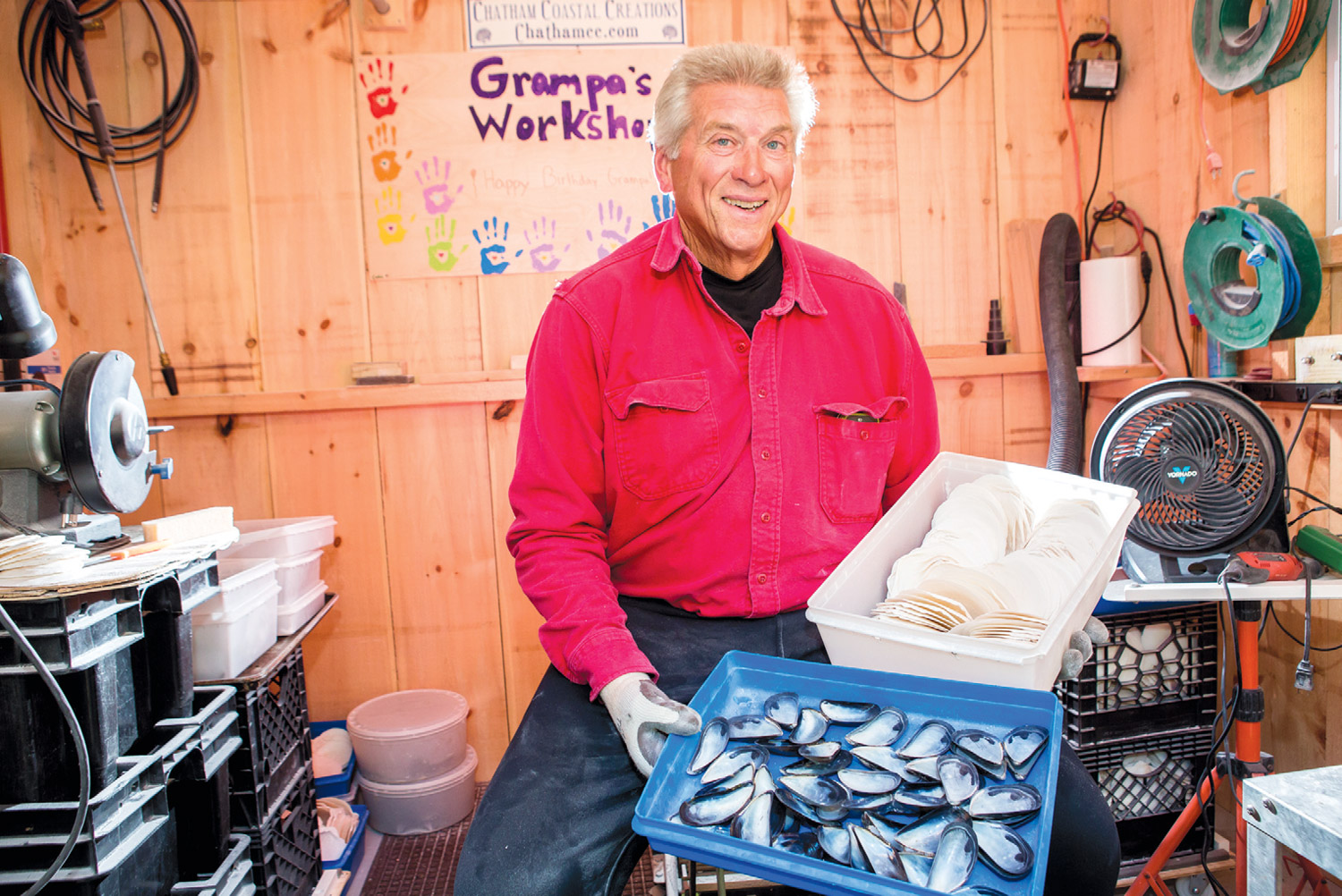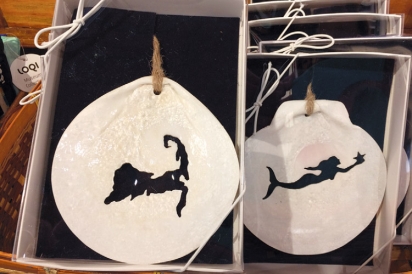Chatham Coastal Creations
Pan-seared in brown butter. Baked au gratin. Tossed with capers and lemon. Wrapped in bacon. There are so many ways to enjoy local Cape Cod sea scallops, but unless you have worked on a scallop boat it is unlikely you’ve ever seen their shells. “The first question everyone asks me is, what kind of shell is that?” says longtime fishermanturned-artisan Nick Nickerson, whose Chatham Coastal Creations uses multitudes of them in his handmade mirrors and ornaments.
While beachcombers regularly spot bay scallop shells, the native sea scallop harvested by Cape Cod fishermen is shucked at sea and the shells are tossed away. “I probably threw thousands of bushels overboard in my day,” says Nickerson, who scalloped for decades. “Who would have ever thought I’d be using them this way now?”
Nickerson’s sideline crafting custom mirrors from the hard white shells began after a bout with cancer kept him on land. He started with wreaths, shadow boxes and napkin rings until he settled on oval and rectangular mirrors encircled by sea scallop shells, which he carefully cleans, culls, sands and shapes in his home workshop after obtaining them from fishermen friends. The custom mirrors became immensely popular and working on them began to take up much of his time.
“I have used mussel shells occasionally too, but the all white of the sea scallop shells is so classy looking and seems to go with everyone’s décor,” says Nickerson, who sells his wares both from his own website and through a network of gift shops across Cape Cod.
His son-in-law’s cut-out bread board business inspired him to begin creating sea scallop Christmas ornaments etched with silhouettes of the map of Cape Cod and other sea-themed images. Using a local company to do the water laser cutting of his designs, he gets incredible detail in the mermaid, whale tail and anchor outlines that adorn the shells. “They came out beautifully,” he says. “It’s unbelievable how precise the process is.” He attempted a codfish silhouette, even getting the littlest detail of the prominent barbell (whisker) on its chin to appear. “But no one could really tell it was a cod.” he said. Fishermen knew what it was, but laypeople thought it could be a catfish, so he has opted for more easily identifiable designs to sell.
Nickerson still creates his mirrors in the basement of his Chatham home, but has expanded his outdoor work area, adding a new 14x24-foot wet belt sanding and production barn to the already established cleaning station and grinding shed in his backyard to accommodate the ornament orders. “They are selling out from Falmouth to Provincetown,” he says about the shell ornaments, which are eclipsing his mirrors in popularity at this point. He continues to be a one-man show in crafting the pieces, but has enlisted his daughter and granddaughter to help with the packaging, and so far Chatham Coastal Creations has produced more than 4000 holiday ornaments over the past year.
“I must have fifteen thousand sea scallops shells in my backyard now,” says Nickerson. “Guys come to the house, and look around and ask ‘What the heck are you doing?’” he says, laughing. “It’s something different, that’s for sure.”
He continues to come up with new ideas for designs—lobster and blue crab silhouettes are the latest—and to market his product up and down the peninsula. “I was grinding shells the other day and I got to thinking about how I always have bought a lot of supplies from Hart Farm in Dennis. So later that day I stop by with my samples and they take them. The next day I get a call—they are all sold out and want more!”
He has been commissioned by some local businesses to create logo-specific silhouetted ornaments, such as the Chatham Bars Inn’s seagull, and to design animal images for various rescue groups. His ornaments are tied with twine and boxed in clear-front packages, with information on the back with the story of the shell: harvested by local fishermen and crafted on Cape Cod.
Having put his own shellfishing boat up for sale recently, Nickerson acknowledges that he is effectively segueing into this new line of work after a lifetime on the water. “It is crazy how it’s all happened,” he says. With all those years spent sending them to the depths, the sea scallop shell is now his stock in trade.






